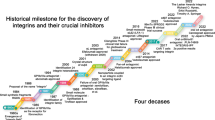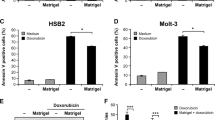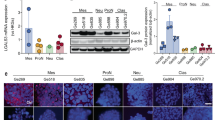Abstract
The extracellular matrix protein lectin galactoside-binding soluble 3 binding protein (LGALS3BP) constitutes a negative prognostic marker of cancer onset and progression with increasing value in clinical application. Since its discovery, however, although the glycoprotein has been implicated in a growing number of disease-related processes, its actual role and mechanism of action have remained ambiguous, thus hindering opportunities for therapeutic development. In this study, we have determined that LGALS3BP constitutes a novel ligand for integrins α1β1, α5β1, αvβ1 and α6β1 and have identified that these newly established partnerships at the membrane level are responsible for exerting the molecule’s involvement in cancer through manipulation of multiple canonical ‘outside-in’ integrin signalling events. We demonstrate that LGALS3BP-mediated integrin activation results into signal transmission via Akt, JNK and the Ras cascade via the Raf-ERK axis while p38 activity is kept at baseline levels. Transient cellular adherence to LGALS3BP favours survival and proliferation signalling while apoptosis is kept at bay. Sustained cellular exposure to LGALS3BP significantly supports viability, motility and migration. Importantly, an anti-LGALS3BP antibody, SP2 is capable of impeding these newly defined LGALS3BP-driven processes without, however, compromising cell viability. These novel findings reveal the mechanism of action of LGALS3BP during cellular adherence and warrant its further validation as a potential pharmacological target for anticancer therapies.
This is a preview of subscription content, access via your institution
Access options
Subscribe to this journal
Receive 50 print issues and online access
$259.00 per year
only $5.18 per issue
Buy this article
- Purchase on Springer Link
- Instant access to full article PDF
Prices may be subject to local taxes which are calculated during checkout












Similar content being viewed by others
References
Hynes RO . The extracellular matrix: not just pretty fibrils. Science 2009; 326: 1216–1219.
Lu P, Weaver VM, Werb Z . The extracellular matrix: a dynamic niche in cancer progression. J Cell Biol 2012; 196: 395–406.
Mbeunkui F, Johann DJ Jr . Cancer and the tumor microenvironment: a review of an essential relationship. Cancer Chemother Pharmacol 2009; 63: 571–582.
Huxley-Jones J, Foord SM, Barnes MR . Drug discovery in the extracellular matrix. Drug Discov Today 2008; 13: 685–694.
Jarvelainen H, Sainio A, Koulu M, Wight TN, Penttinen R . Extracellular matrix molecules: potential targets in pharmacotherapy. Pharmacol Rev 2009; 61: 198–223.
Martinez VG, Moestrup SK, Holmskov U, Mollenhauer J, Lozano F . The conserved scavenger receptor cysteine-rich superfamily in therapy and diagnosis. Pharmacol Rev 2011; 63: 967–1000.
Iacobelli S, Sismondi P, Giai M, D'Egidio M, Tinari N, Amatetti C et al. Prognostic value of a novel circulating serum 90K antigen in breast cancer. Br J Cancer 1994; 69: 172–176.
Ozaki Y, Kontani K, Hanaoka J, Chano T, Teramoto K, Tezuka N et al. Expression and immunogenicity of a tumor-associated antigen, 90K/Mac-2 binding protein, in lung carcinoma. Cancer 2002; 95: 1954–1962.
Sardana G, Marshall J, Diamandis EP . Discovery of candidate tumor markers for prostate cancer via proteomic analysis of cell culture-conditioned medium. Clin Chem 2007; 53: 429–437.
Xue H, Lu B, Lai M . The cancer secretome: a reservoir of biomarkers. J Transl Med 2008; 6: 52.
Ulmer TA, Keeler V, Loh L, Chibbar R, Torlakovic E, Andre S et al. Tumor-associated antigen 90K/Mac-2-binding protein: possible role in colon cancer. J Cell Biochem 2006; 98: 1351–1366.
Scambia G, Panici PB, Baiocchi G, Perrone L, Iacobelli S, Mancuso S . Measurement of a monoclonal-antibody-defined antigen (90K) in the sera of patients with ovarian cancer. Anticancer Res 1988; 8: 761–764.
Cesinaro AM, Natoli C, Grassadonia A, Tinari N, Iacobelli S, Trentini GP . Expression of the 90K tumor-associated protein in benign and malignant melanocytic lesions. J Invest Dermatol 2002; 119: 187–190.
Carlin CR, Knowles BB . Identification of a 90 000-Dalton cell surface glycoprotein with elevated expression in human hepatoma cells. Exp Cell Res 1983; 147: 359–367.
Iacovazzi PA, Trisolini A, Barletta D, Elba S, Manghisi OG, Correale M . Serum 90K/MAC-2BP glycoprotein in patients with liver cirrhosis and hepatocellular carcinoma: a comparison with alpha-fetoprotein. Clin Chem Lab Med 2001; 39: 961–965.
Kashyap MK, Harsha HC, Renuse S, Pawar H, Sahasrabuddhe NA, Kim MS et al. SILAC-based quantitative proteomic approach to identify potential biomarkers from the esophageal squamous cell carcinoma secretome. Cancer Biol Ther 2010; 10: 796–810.
Park YP, Choi SC, Kim JH, Song EY, Kim JW, Yoon DY et al. Up-regulation of Mac-2 binding protein by hTERT in gastric cancer. Int J Cancer 2007; 120: 813–820.
Zhang DS, Jiang WQ, Li S, Zhang XS, Mao H, Chen XQ et al. [Predictive significance of serum 90K/Mac-2BP on chemotherapy response in non-Hodgkin's lymphoma]. Ai Zheng 2003; 22: 870–873.
Koopmann J, Thuluvath PJ, Zahurak ML, Kristiansen TZ, Pandey A, Schulick R et al. Mac-2-binding protein is a diagnostic marker for biliary tract carcinoma. Cancer 2004; 101: 1609–1615.
Srirajaskanthan R, Caplin ME, Waugh MG, Watkins J, Meyer T, Hsuan JJ et al. Identification of Mac-2-binding protein as a putative marker of neuroendocrine tumors from the analysis of cell line secretomes. Mol Cell Proteomics 2010; 9: 656–666.
Grassadonia A, Tinari N, Iurisci I, Piccolo E, Cumashi A, Innominato P et al. 90K (Mac-2 BP) and galectins in tumor progression and metastasis. Glycoconj J 2004; 19: 551–556.
Fornarini B, D'Ambrosio C, Natoli C, Tinari N, Silingardi V, Iacobelli S . Adhesion to 90K (Mac-2 BP) as a mechanism for lymphoma drug resistance in vivo. Blood 2000; 96: 3282–3285.
Ullrich A, Sures I, D'Egidio M, Jallal B, Powell TJ, Herbst R et al. The secreted tumor-associated antigen 90K is a potent immune stimulator. J Biol Chem 1994; 269: 18401–18407.
Sasaki T, Brakebusch C, Engel J, Timpl R . Mac-2 binding protein is a cell-adhesive protein of the extracellular matrix which self-assembles into ring-like structures and binds beta1 integrins, collagens and fibronectin. EMBO J 1998; 17: 1606–1613.
Block AS, Saraswati S, Lichti CF, Mahadevan M, Diekman AB . Co-purification of Mac-2 binding protein with galectin-3 and association with prostasomes in human semen. Prostate 2011; 71: 711–721.
Barczyk M, Carracedo S, Gullberg D . Integrins. Cell Tissue Res 2010; 339: 269–280.
Geiger B, Yamada KM . Molecular architecture and function of matrix adhesions. Cold Spring Harb Perspect Biol 2011; 3: a005033.
Han S, Khuri FR, Roman J . Fibronectin stimulates non-small cell lung carcinoma cell growth through activation of Akt/mammalian target of rapamycin/S6 kinase and inactivation of LKB1/AMP-activated protein kinase signal pathways. Cancer Res 2006; 66: 315–323.
Oktay M, Wary KK, Dans M, Birge RB, Giancotti FG . Integrin-mediated activation of focal adhesion kinase is required for signaling to Jun NH2-terminal kinase and progression through the G1 phase of the cell cycle. J Cell Biol 1999; 145: 1461–1469.
Bode AM, Dong Z . The functional contrariety of JNK. Mol Carcinog 2007; 46: 591–598.
Dreskin SC, Thomas GW, Dale SN, Heasley LE . Isoforms of Jun kinase are differentially expressed and activated in human monocyte/macrophage (THP-1) cells. J Immunol 2001; 166: 5646–5653.
Ono K, Han J . The p38 signal transduction pathway: activation and function. Cell Signal 2000; 12: 1–13.
Hood JD, Cheresh DA . Role of integrins in cell invasion and migration. Nat Rev Cancer 2002; 2: 91–100.
Van Slambrouck S, Jenkins AR, Romero AE, Steelant WF . Reorganization of the integrin alpha2 subunit controls cell adhesion and cancer cell invasion in prostate cancer. Int J Oncol 2009; 34: 1717–1726.
Faccio R, Grano M, Colucci S, Villa A, Giannelli G, Quaranta V et al. Localization and possible role of two different alpha v beta 3 integrin conformations in resting and resorbing osteoclasts. J Cell Sci 2002; 115: 2919–2929.
Snider JL, Allison C, Bellaire BH, Ferrero RL, Cardelli JA . The beta1 integrin activates JNK independent of CagA, and JNK activation is required for Helicobacter pylori CagA+-induced motility of gastric cancer cells. J Biol Chem 2008; 283: 13952–13963.
Zhang H, Ozaki I, Mizuta T, Yoshimura T, Matsuhashi S, Eguchi Y et al. Transforming growth factor-beta 1-induced apoptosis is blocked by beta 1-integrin-mediated mitogen-activated protein kinase activation in human hepatoma cells. Cancer Sci 2004; 95: 878–886.
Awasthi N, Zhang C, Hinz S, Schwarz MA, Schwarz RE . Enhancing sorafenib-mediated sensitization to gemcitabine in experimental pancreatic cancer through EMAP II. J Exp Clin Cancer Res 2013; 32: 12.
Goodman SL, Picard M . Integrins as therapeutic targets. Trends Pharmacol Sci 2012; 33: 405–412.
Lu X, Lu D, Scully M, Kakkar V . The role of integrins in cancer and the development of anti-integrin therapeutic agents for cancer therapy. Perspect Medicin Chem 2008; 2: 57–73.
Marchetti A, Tinari N, Buttitta F, Chella A, Angeletti CA, Sacco R et al. Expression of 90K (Mac-2 BP) correlates with distant metastasis and predicts survival in stage I non-small cell lung cancer patients. Cancer Res 2002; 62: 2535–2539.
Ruegg C, Mariotti A . Vascular integrins: pleiotropic adhesion and signaling molecules in vascular homeostasis and angiogenesis. Cell Mol Life Sci 2003; 60: 1135–1157.
Niland S, Eble JA . Integrin-mediated cell-matrix interaction in physiological and pathological blood vessel formation. J Oncol 2012; 2012: 125278.
Piccolo E, Tinari N, Semeraro D, Traini S, Fichera I, Cumashi A et al. LGALS3BP, lectin galactoside-binding soluble 3 binding protein, induces vascular endothelial growth factor in human breast cancer cells and promotes angiogenesis. J Mol Med 2013; 91: 83–94.
Natoli C, Dianzani F, Mazzotta F, Balocchini E, Pierotti P, Antonelli G et al. 90K protein: a new predictor marker of disease progression in human immunodeficiency virus infection. J Acquir Immune Defic Syndr 1993; 6: 370–375.
Pelliccia P, Natoli C, Petitti MT, Verrotti A, Chiarelli F, Iacobelli S . Elevated levels of circulating immunostimulatory 90K in Henoch-Schoenlein purpura. J Clin Immunol 1999; 19: 143–147.
Ohshima S, Kuchen S, Seemayer CA, Kyburz D, Hirt A, Klinzing S et al. Galectin 3 and its binding protein in rheumatoid arthritis. Arthritis Rheum 2003; 48: 2788–2795.
Lee YJ, Kang SW, Song JK, Park JJ, Bae YD, Lee EY et al. Serum galectin-3 and galectin-3 binding protein levels in Behcet's disease and their association with disease activity. Clin Exp Rheumatol 2007; 25: S41–S45.
Mould AP . Analyzing integrin-dependent adhesion. in: Juan S Bonifacino et al. eds Current protocols in cell biology/editorial board, 2011, Chapter 9: Unit 9.4.
Mould PA . Solid phase assays for studying ECM protein-protein interactions. Methods Mol Biol 2009; 522: 195–200.
Eisenach PA, Roghi C, Fogarasi M, Murphy G, English WR . MT1-MMP regulates VEGF-A expression through a complex with VEGFR-2 and Src. J Cell Sci 2010; 123: 4182–4193.
Author information
Authors and Affiliations
Corresponding author
Ethics declarations
Competing interests
The authors declare no conflict of interest.
Rights and permissions
About this article
Cite this article
Stampolidis, P., Ullrich, A. & Iacobelli, S. LGALS3BP, lectin galactoside-binding soluble 3 binding protein, promotes oncogenic cellular events impeded by antibody intervention. Oncogene 34, 39–52 (2015). https://doi.org/10.1038/onc.2013.548
Received:
Revised:
Accepted:
Published:
Issue Date:
DOI: https://doi.org/10.1038/onc.2013.548
Keywords
This article is cited by
-
Impaired bisecting GlcNAc reprogrammed M1 polarization of macrophage
Cell Communication and Signaling (2024)
-
Injury-specific factors in the cerebrospinal fluid regulate astrocyte plasticity in the human brain
Nature Medicine (2023)
-
New approaches for developing biomarkers of hormonal contraceptive use
Scientific Reports (2023)
-
Role of galectin 3 binding protein in cancer progression: a potential novel therapeutic target
Journal of Translational Medicine (2021)
-
Plasma exosomes from endometrial cancer patients contain LGALS3BP to promote endometrial cancer progression
Oncogene (2021)



